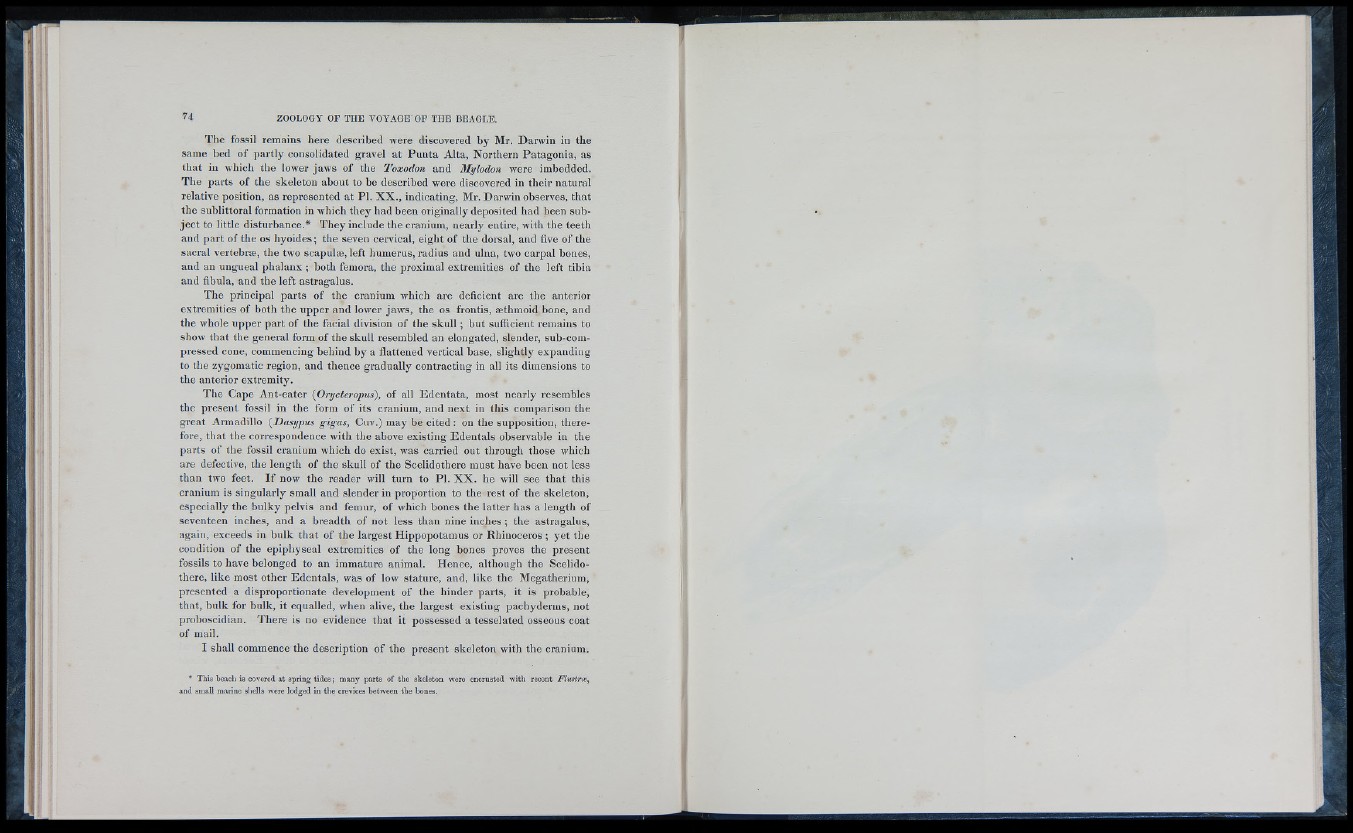
The fossil remains here described were discovered b y Mr. Darwin in the
same bed o f partly consolidated gravel at Pu n ta Alta, Northern Patagonia, as
that in which the lower jaw s o f the Toxodon and Mylodon were imbedded.
The parts o f the skeleton about to be described were discovered in their natural
relative position, as represented at PI. X X ., indicating, Mr. Darwin observes, that
the sublittoral formation in which they had b een originally deposited had been subj
e c t to little disturbance.* T h ey include the cranium, nearly entire, with the teeth
and part o f the os hyoides; the seven cervical, eight o f the dorsal, and five o f the
sacral vertebræ, the two scapulæ, le ft humerus, radius and ulna, two carpal bones,
and an ungueal phalanx ; both femora, the proximal extremities o f the le ft tibia
and fibula, and the le ft astragalus.
The principal parts o f the cranium which are deficient are the anterior
extremities o f both the upper and lower jaws, the os frontis, æthmoid bone, and
the whole upper part o f the facial division o f the skull ; but sufficient remains to
show that the general form o f the skull resembled an elongated, slender, sub-compressed
cone, commencing behind by a flattened vertical base, sligh tly expanding
to the zygomatic region, and thence gradually contracting in all its dimensions to
the anterior extremity.
Th e Cape Ant-eater {Orycteropus), o f all Edentata, most nearly resembles
the present fossil in the form o f its cranium, and nex t in this comparison the
great Armadillo {Dasypus g ig a s , Cuv.) may be c ited : on the supposition, therefore,
that the correspondence with the above ex isting Edenta ls observable in the
parts o f the fossil cranium which do exist, was carried out through those which
are defective, the length o f the skull o f the Scelidothere must have been not le ss
than two feet. I f now the reader will turn to PI. X X . he will se e that this
cranium is singularly small and slender in proportion to the rest o f the skeleton,
especially the bulky pelvis and femur, o f which bones the latter has a length o f
seventeen inches, and a breadth o f not le ss than nine inches ; the astragalus,
again, exc eeds in bulk that o f the largest Hippopotamus or Rhinoceros ; y e t the
condition o f the epiphyseal extremities o f the long bones proves the present
fossils to have belonged to an immature animal. Henc e, although the Scelidothere,
lik e most other Edentals, was o f low stature, and, lik e the Megatherium,
presented a disproportionate development o f the hinder parts, it is probable,
that, bulk for bulk, it equalled, when alive, the largest ex isting pachyderms, not
proboscidian. There is no evidence that it possessed a tesselated osseous coat
o f mail.
I shall commence the description o f the present ske leton with the cranium.
• This beach is covered at spring tides; many parts of tlie skeleton were encrusted with recent Flustnx,
and small marine sliells were lodged in tlie crevices between tlie bones.